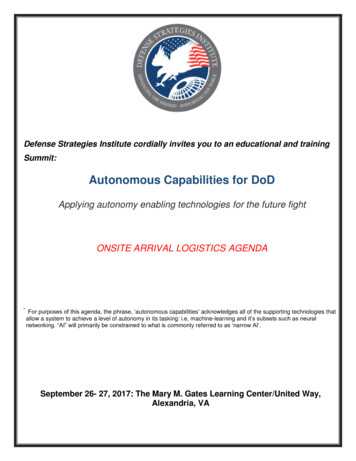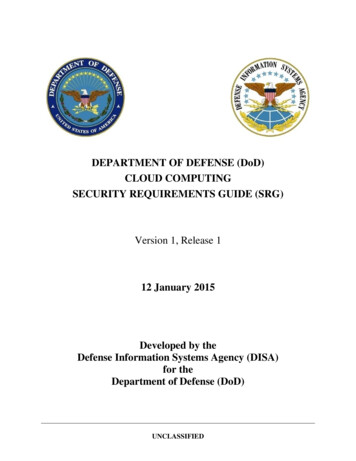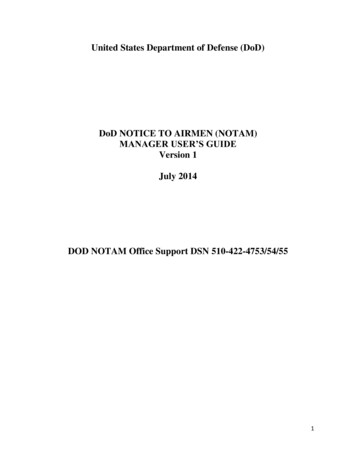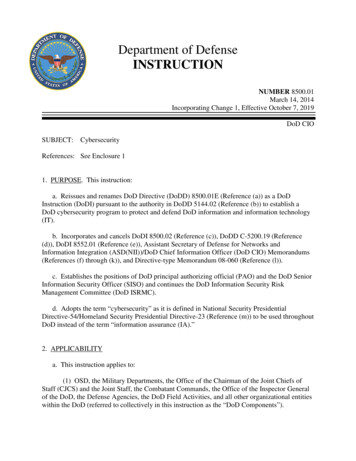
Transcription
Defense Strategies Institute cordially invites you to an educational and trainingSummit:Autonomous Capabilities for DoDApplying autonomy enabling technologies for the future fightONSITE ARRIVAL LOGISTICS AGENDA*For purposes of this agenda, the phrase, ‘autonomous capabilities’ acknowledges all of the supporting technologies thatallow a system to achieve a level of autonomy in its tasking: i.e, machine-learning and it’s subsets such as neuralnetworking. “AI” will primarily be constrained to what is commonly referred to as ‘narrow AI’.September 26- 27, 2017: The Mary M. Gates Learning Center/United Way,Alexandria, VA
The Summit will take place at the Mary M. Gates Learning Center/ UNITED WAY Building:701 N. Fairfax St. Alexandria, VA , Corner of Madison St, one block west of the Potomac River.http://www.marygateslearningcenter.com (please DO NOT call the Center for logistics, contact DSI)LOCATION:PARKING:1.) There is NO parking at the Center (there is a small lot but this is reserved for United Waystaff.)2.) Street: Parking is available on the street (some spots limited to 2 hours)3.) Paid: Two walking blocks from the Center, same side of street. at:Crowne Plaza Hotel : 901 North Fairfax Rd. Ground Floor, open air. Up to 20 per day.Paid parking also at Sheraton Suite Hotel 801 N St Asaph St – two blocks west on Madison StFrom the Center, but they charge more than Crowne Plaza. Currently near 25 per day.METRO:Braddock Road Station: Walk roughly 10 blocks east on Madison until you hit North Fairfax- TheLearning Center will be one block away.(about a 10 -15 min walk)ARRIVALLOGISTICS:conferenceroom logistics:Upon arrival, you will enter through glass doors. Directly to your right will be another set of glassdoors, about 10 feet from the entrance. We are located directly through these glass doors – you willbe able to see us upon entering the building.A DSI staff member will be at the registration desk to greet you. Please sign in and pick up yourbadge and booklet and sign in. Badges must be worn at all times**This Event is No Press // Non-Attribution // No Recordings**Your main POC:Ms. Monica Mckenzie, Senior Partner, DSI Cell phone: 1-917-435-1266Email: mckenzie@dsigroup.orgONSITE POCsfrom DSI:Secondary ONSITE POC:Ms Morgan Colfax, Marketing Manager, DSI201.266.0058 mcolfax@dsigroup.orgDRESS CODE:ATTENDEES:Military: Duty Uniform of the Day Civilian: Business casual: jacket and slacks requested, tie optionalWIFIWe will provide you with complimentary WIFI: you may bring your own device. NO PICTURES ORRECORDINGS allowed inside conference room. Complimentary access to business center withcomputers, phones, and printers.
Food andbeverageFOOD AND BEVERAGE:We will provide fresh coffee, teas, beverages, breakfast, snacks and a full lunch on both days.Breakfast will include a variation of fresh stuffed croissants, fresh fruit salad, yogurt, mid morningcheese and crackers and muffins. Lunches will be served buffet style and include a salad andvegetable side and main dishes of chickens and pastas. Afternoon snacks are a variety of freshdesserts and cakes.MIL and GOV : your per person price for lunch and beverage falls below general per diemrates set by Military and GSA specificallyBullet points subject to edits by speakersDay 1: TUESDAY September 26, 20177:30 – 8:30Registration and Networking Breakfast8:35 – 8:50Opening Welcome and RemarksMonica Mckenzie: DSI, Senior PartnerCol (ret) Scott Heritsch, USAF. Summit Volunteer Moderator – bio’s on last page8:50 – 9:20Reflections and Future Opportunities / Challenges for Autonomous Capabilities in the Navy & Across DoDDr. Lawrence Schuette (immediate former Director of Research, SES, ONR; Chair, Autonomy COI for DoD(under ASD R&E) (confirmed)9:20- 10:00Algorithmic Warfare Cross Functional Team: Integrating big data and machine learning across the military-Understanding the mission, priorities and goals of the AWCFT-How the AWCFT is approaching the acquisition and development of algorithms and determining computationalresources for 90-day sprints-Update on OUSD(I) sponsored AI-based opportunities (Xpress Challenge) for generating analytic productsCol Drew Cukor, USMC, Chief, Algorithmic Warfare Cross Function Team, ISR Operations Directorate,Warfighter Support, Office of the Undersecretary of Defense for Intelligence (confirmed)10:00 -10:30Networking Break10:30- 11:10Acquisition Perspective towards Autonomous Capabilities for Future Concepts and Mission CapabilityNeeds Across DoD-Prime areas of interest for the potential applications of machine-learning, and varying levels of automationthroughout the strategic, operational, and tactical levels of DoD systems-Designing for the future: Perspective towards approaching and developing acquisition options for insertingautonomous capabilities into current systems and platforms and what industry and R&D partners need to knowMr. Dyke Weatherington, Deputy Assistant Secretary of Defense (DASD) for Space,Strategic & Intel Systems (SSI) (confirmed)11:10-11:50Maintaining Military Overmatch through Innovation Utilizing Autonomous Capabilities-Re-imagining today’s capabilities for tomorrow’s fight: viewpoint towards where autonomous capabilities could bestbe applied across DoD-Treating data as a strategic resource: using big data analytics and machine learning-Challenges and concerns towards rapid insertion (trust, TEVV )-Thoughts for the private and public sector for their R&D efforts with autonomous capabilities and their potentialapplications for future conceptsDr. William Roper, Director, Strategic Capabilities Office, OSD (confirmed)11:50 -12:30Autonomous Mission Package Planning and Execution (AMPPE) : Framework for Autonomy ProjectsMr. Fred ‘Fritz’ Schulz, Oversight Executive - Battlespace Awareness, Emerging TechOSD Research & Engineering, Emerging Capability & Prototyping (tentative)Previously the following session was to occur: Autonomous Capabilities for Future Concepts and Mission CapabilityNeeds Across USSTRATCOM-Mr. Kenneth S. Callicutt, SES, J8 Director, Capability and Resource Integration (USSTRATCOM) (cancelled due tondtravel needs as of Sept 22 .)12:40– 1:30Networking Lunch
1:30 – 2:10Autonomous Capabilities for Unmanned Systems for the Navy-Current pulse on Naval opportunities for inserting autonomous capabilities into current and near term systems-Considerations and challenges towards trust / over-trust of such systems-Developing resource scenario options: long-range plans and designing operational capabilities-based requirementsfor autonomous capabilities. What industry and research partners need to knowMr. Frank Kelley, DASN, UxS (confirmed)2:10- 2:50ARCIC: Autonomous Capabilities for the Warfighter to Improve Overmatch-Future applications of consideration for autonomous capabilities:( increase situational awareness; lighten thewarfighters’ physical and cognitive workloads; sustain the force with increased distribution, throughput, andefficiency; facilitate movement and maneuver; and increase force protection)-Current activities for integrating autonomous capabilities in the Common Operating Environment-Supporting foundation for pursuing RAS : common standards, government-owned architecture, interoperability,common platforms, and modular payloads, cyber protection and mission assuranceMr. Ed Mazzanti, Deputy Director, Capabilities Developments (ARCIC), TRADOC (confirmed)2:50 – 3:10Networking Break3:10 – 3:50DIA: Getting ahead of the data: Applying autonomous capabilities to the Intelligence enterprise-Where DIA sees the opportunity to apply machine-learning, and varying levels of automation throughout thestrategic, operational, and tactical levels-Defining the boundaries of man and machine: How do you define the limits of what “shallow tasks” can be given tocomputing and where deep thinking and decision-making should still be left to the human analyst-How DIA is approaching the development of a culture of trust and balancing the challenge of ‘over-trust’ withautonomous capabilities and analyticsMr. James Harris, CTO, DIA (confirmed)3:50 – 4:30Applying Autonomous Capabilities to Improve the Efficiency and Effectiveness of USTRANSCOM’sDistribution Technologies-Current areas of interest where autonomous capabilities could aid in support of systems at-rest and in-motionacross USTRANSCOM’s global “supply chain”Mr. Lou Bernstein, RDT&E Program Director, USTRANSCOM (confirmed)4:45End of Day 1DAY 2, Wednesday September 27, 20177:30 – 8:458:40 – 8:50Registration and morning networking breakfastRecap summary of Day 18:50 – 9:30Army Acquisition Perspective towards Exploiting Autonomous Capabilities to Achieve and Maintain TotalCombat Superiority-How ASA ALT is approaching and supporting the acquisition of collaborative human-machine battle networks-Current considerations and challenges towards acquiring and inserting autonomous capabilities ,and whatindustry and R&D partners need to knowDr. Robert Sadowski, SES, Army Chief Roboticist, TARDEC (confirmed)9:30 – 10:10Collaborative Autonomy: A Tactical Offset Strategy-Integrating intelligent systems as force multipliers for improving the effectiveness and reach of Soldiers in complexmilitary relevant environments: understanding ARL’s vision and research towards a heterogeneous mix betweenSoldier and sensors and machines with varying levels of cognition-Viewpoint towards the challenges with TEVV and ‘over-trust’ of such capabilities-Where ARL is towards scaling intelligent systems down in size to enable collaborative systems for realizabledismounted Soldier ISR assetDr. Brian Sadler, Senior Research Scientist (ST) for Intelligent Systems, ARL (confirmed)10:10- 10:4010:40- 11:20Networking BreakAutonomous Capabilities / Machine-learning for ISR-Where Air Force sees the opportunity to apply machine-learning, and varying levels of automation throughout thestrategic, operational, and tactical levels of ISR-Defining the boundaries of man and machine: How do you define the limits of what “shallow tasks” can be given tocomputing and where deep thinking and decision-making should still be left to the human analystMr. Kenneth Bray, Civilian Assistant Deputy Chief of Staff for ISR, HQAF (confirmed)
11:20-12:00Advancing the Science and Technology of Autonomous Capabilities for the Air Force-Building the Backbone for narrow AI: Air Force’s current concentration on innovative technologies to explore anddevelop computational capabilities with greater sophistication, autonomy, intelligence, and assurance-Making platforms more autonomous with multi-infusion systems and data from across different intelligence streams-Human /autonomy teaming-Autonomy oversight and interaction: Understanding the vital situational awareness levels and their components-Understanding ‘flexible autonomy’, and ways to improve human trustDr. Greg Zacharias, Chief Scientist, USAF (confirmed)12:00- 12:40Autonomous Capabilities for the Cyber Domain-Where CYBERCOM sees the application of future autonomous capabilities best suited for their mission needs-Perspective towards ‘counter-autonomy’: applying machine-learning capabilities to help predict and defeat futureattacks across the entire network-Defining the boundaries of man and machine: How do you define the limits of what “shallow tasks” can be given tocomputing and where deep thinking and decision-making should still be left to the human analyst?Mr. Shawn Turskey, Executive Director, USCYBERCOM (confirmed)12:40- 1:151:15- 1:55Networking LunchDARPA: XAI Explainable Artificial Intelligence Program-Producing more explainable models, while maintaining a high level of learning performance (prediction accuracy)-Enabling human users to understand, appropriately trust, and effectively manage the emerging generation ofartificially intelligent partnersMr. David Gunning, PM, I2O, DARPA (confirmed)1:55- 2:35Applying Autonomous Capabilities to Improve the Efficiency and Effectiveness of JIDO’s Mission Needs-Where JIDO sees the potential and continued application of autonomous capabilities to meet warfighter capabilitygaps countering today’s improvised threats as well as against those anticipated in the near future-Defining the boundaries of man and machine: How do you define the limits of what “tasks” can be given tocomputing and where deep thinking and decision-making should still be left to the human operator/analyst-Current considerations and challenges towards rapidly acquiring and inserting autonomous capabilities ,and whatindustry and R&D partners need to know about JIDO’s approachMr. Leonel Garciga, J6/CTO, JIDO, DTRA; ; Dr. Nina Berry, Science and Technology Advisor to JIDO(confirmed)2:35- 3:10“Automated Sense making. Multi-INT Fusion. Activity Based Intelligence. Big Data. The Cloud. MachineLearning: making autonomous sense of data from multiple disparate domains for intelligence analysts”-Practical state-of-the-art near real-time AF DCGS multi-INT data fusion application.-Exploring simulated cities and their data for data fusion.-Promises and Limits of automation and machine learning in intelligence analysis tasks.-Opportunities and Challenges in leveraging academic partners for autonomous multi-INT data fusion development.Shane R. G. Carleton, Senior Research Engineer, Applied Systems Laboratory, Georgia Tech ResearchInstitute (confirmed)3:10 – 3:50Hold for Closing Session4:00pmEnd of SummitBullet points subject to edits by speakersOPERATING GUIDANCE FOR MILITARY AND GOVERNMENT (Federal, State) ATTENDEES:DSI's Summit is open and complimentary to all U.S. DoD, Federal and State employees and is considered a compliant education andtraining forum.Questions, please contact Monica Mckenzie : 1.917.435.1266 IOs on MODERATORS ON NEXT PAGE
Col (ret) Scott Heritsch, USAF, Volunteer Moderator:DSI has asked Col (ret) Heritsch to volunteer his time to help us moderate Q&A and discussion time. Heis on deck to lend his expertise and knowledge and will help us to elevate the level of the discussions we willattempt to draw out. While his role is informal, DSI is truly thankful for his acceptance to help us.Scott recently retired from the United States Air Force in July of 2017. Just prior to his retirement, ColonelHeritsch was the Director of Air Force International Programs for the Defense Security Cooperation Agency.From 2014 to 2016 he was the Science and Technology Lead for the Joint Staff Robotics and AutonomousSystems Team as well as the Branch Chief, Asset Protection Branch, Force Protection Division, J8, Joint Staff.While at the Pentagon he guided the Joint Staff's vision in robotics, autonomous systems, future war fightingconcepts and defense architectures. In this capacity he served as the Executive Secretary for the DefenseScience Board’s 2015 Summer Study on Autonomy and was a DARPA Service Chiefs Fellow helping to provideoperational context to DARPA program managers with an emphasis in autonomy, AI and space architectures.Prior to his time in DC, Scott was Commander of the 586th Flight Test Squadron (T-38C and C-12J) and theOperations Officer of a selectively manned flight test squadron directing classified flight test for prototypeaircraft. As an operational F-16 pilot, he deployed to the Southwest Asia and Korean theaters. His educationincludes an MS in National Security Studies from the National Defense University with an emphasis in therobotics and autonomous systems industry, USAF Test Pilot School, an MS in Electrical Engineering from UtahState University and a BS in Electrical Engineering from the USAF Academy.DSI onsite POC: Monica Mckenzie, Senior Partner, Defense Strategies InstituteSenior Partner and founding member, Defense Strategies Institute (Oct 2011- present). Former Head ofGovernment Relations, Global Strategies Group; former Associate for 2nd Committee, United Nations. MastersDegree in International Politics & Conflict Negotiation, School of International Service, American University, D.C.Certification in Military Conflict Negotiation, Inter-American Defense College, Ft. McNair, D.C
11:20-12:00 Advancing the Science and Technology of Autonomous Capabilities for the Air Force-Building the Backbone for narrow AI: Air Force's current concentration on innovative technologies to explore and develop computational capabilities with greater sophistication, autonomy, intelligence, and assurance -Making platforms more autonomous with multi-infusion systems and data from across .










